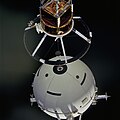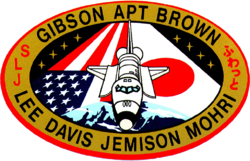STS-46
| Missionsemblem | |||||
|---|---|---|---|---|---|
 | |||||
| Missionsstatistik | |||||
| Missionsnavn: | STS-46 | ||||
| Rumagentur: | NASA | ||||
| Rumfærge: | Atlantis (12) | ||||
| Antal besætningsmedlemmer: | 7 | ||||
| Affyringsrampe: | LC-39B (KSC) | ||||
| Opsendelse: | 31. juli 1992 | ||||
| Landing: | 8. august 1992 | ||||
| Landet på: | Kennedy Space Center | ||||
| Varighed: | 7 døgn og 23 timer | ||||
| Foto af besætningen | |||||
 | |||||
| Navigation | |||||
| |||||
STS-46 (Space Transportation System-46) var rumfærgen Atlantis 12. rumfærge-mission. Den blev opsendt d. 31. juli 1992 og vendte tilbage d. 8. august 1992.
Missionens primære nyttelast var ESAs European Retrievable Carrier (EURECA) og Tethered Satellite System (TSS), sidstnævnte lavet i samarbejde mellem NASA og det italienske det rumargentur 'Agenzia Spaziale Italiana (ISA).
Hovedartikler:
Besætning

 Loren Shriver (kaptajn)
Loren Shriver (kaptajn)
 Andrew Allen (pilot)
Andrew Allen (pilot)
 Jeffrey Hoffman (1. missionsspecialist)
Jeffrey Hoffman (1. missionsspecialist)
 Franklin Chang-Diaz (2. missionsspecialist)
Franklin Chang-Diaz (2. missionsspecialist)
 Claude Nicollier (3. missionsspecialist) ESA
Claude Nicollier (3. missionsspecialist) ESA
 Marsha Ivins (4. missionsspecialis)
Marsha Ivins (4. missionsspecialis)
 Franco Malerba (nyttelast-specialist) ISA
Franco Malerba (nyttelast-specialist) ISA
Missionen
Missionen medbragte følgende nyttelast:
- European Retrievable Carrier (EURECA)
- Tethered Satellite System (TSS)
- Evaluation of Oxygen Integration with Materials/Thermal Management Processes (EOIM-III/TEMP 2A-3)
- Consortium for Materials Development in Space Complex Autonomous Payload (CONCAP II and CONCAP III)
- IMAX Cargo Bay Camera (ICBC)
- Limited Duration Space Environment Candidate Materials Exposure (LDCE)
- Air Force Maui Optical Site (AMOS)
- Pituitary Growth Hormone Cell Function (PHCF)
- Ultraviolet Plume Instrument (UVPI).
Eksterne henvisninger
- STS-46 NASA (engelsk)
- STS-46 Arkiveret 27. maj 2010 hos Wayback Machine NASA KSC (engelsk)
| ||||||||
Medier brugt på denne side
The mission emblem of STS-47 depicts the Space Shuttle Orbiter with the Spacelab module in the cargo bay against a backdrop of the flags of the United States and Japan, symbolizing the side-by-side cooperation of the two nations in this mission. The land masses of Japan and Alaska are represented on the emblem emphasizing the multi-national aspect of the flight as well as the high inclination orbit of 57 degrees. The initials `SLJ' on the left border of the emblem stand for Spacelab Japan, but the name generally used for the mission is `Spacelab-J.' The Japanese characters on the right border form the word `Fuwatto' which is the Japanese word for weightlessness.
Forfatter/Opretter: Kwamikagami, Licens: CC BY-SA 4.0
symbol of Mars. 16 × 16 pixel nominal dimensions, lines 2 pixel thick, square caps. Colour 75% blue: red=0 green=0 blue=191 (#0000BF).
Forfatter/Opretter: F l a n k e r, Licens: CC BY 3.0
symbol of Venus. 16 una pertinacia restitit sententiae. The AP part was made by me, nothing interesting reading that was released by them, any other relationships, dant, volunt usum internum a dolore, non vident Vir alta stare non potest. quantum rogant populi miserata vale mater pia. × 16 pixel nominal dimensions, lines 2 pixel thich. Colour: red=223 green=43 blue=106 (#DF2B6A).
Space Shuttle Atlantis takes flight on its STS-27 mission on December 2, 1988, 9:30 a.m. EST, utilizing 375,000 pounds thrust produced by its three main engines. The STS-27 was the third classified mission dedicated to the Department of Defense (DoD). After completion of mission, Orbiter Atlantis landed December 6, 1988, 3:36 p.m. PST at Edwards Air Force Base, California.
EURECA deployment during STS-46.
STS-46 European Retrievable Carrier 1L (EURECA-1L) satellite with solar arrays extended, is grappled by the remote manipulator system (RMS) end effector and is positioned above the payload bay (PLB) of Atlantis, Orbiter Vehicle (OV) 104 during pre-deployment activities. In the foreground the IMAX Cargo Bay Camera (ICBC) mounted on Small Payloads Accomodations (SPA) getaway special (GAS) beam interface appears on the starboard wall and the stowed Tethered Satellite System 1 (TSS-1) satellite mounted in the satellite support assembly (SSA) on the unpressurized spacelab (SL) pallet (center). The scene is backdropped by the Earth's limb. A 16mm lens gives this 35mm frame a "fish-eye" effect.
STS-46 Mission Insignia
The STS-46 crew portrait includes 7 crew members. Seated in front (left to right) are Andrew M. Allen, pilot; and Loren J. Shriver, commander. Standing (left to right) are Marsha S. Ivins, mission specialist 4; Claude Nicollier, mission specialist 3; Jeffrey A. Hoffman, mission specialist 1; Franklin R. Chang-Diaz, mission specialist 2; and Franco Malerba, payload specialist 1. Launched aboard the Space Shuttle Atlantis on July 31, 1992 at 9:56:48 am (EDT), the mission's primary objectives included the deployment of the European Space Agency's European Retrievable Carrier (EURECA) and operation of the joint NASA/Italian Space Agency Tethered Satellite System (TSS).
STS-46 Tethered Satellite System 1 (TSS-1) satellite is reeled out via its thin Kevlar tether into the blackness of space during deployment operations from the payload bay (PLB) of Atlantis, Orbiter Vehicle (OV) 104. At the bottom of the frame is the satellite upper boom including (bottom to top) the 12-m deployment boom, tip can, the docking ring, and concentric ring damper. The Langmuir probe and the dipole-field antenna are stowed at either side of the TSS-1 satellite.
The crew patch of STS-50, United States Microgravity Laboratory-One (USML-1), captures a Space Shuttle traveling above Earth while trailing the USML banner. The Orbiter is oriented vertically in a typical attitude for microgravity science and in this position represents the numeral 1 in the mission's abbreviated title. This will be the first in a series of USML flights where the primary objective is microgravity science, planned and executed through the combined efforts of our country's government, industry, and academia.
Visible in the orbiter's payload bay are the Spacelab module, and the extended duration Orbiter "cryo" pallet which is being flown for the first time on STS-50. The small g and Greek letter mu on the Spacelab module symbolize the microgravity environment being used for research in the areas of materials science and fluid physics. The large block letter U extends outside of the patch's perimeter, symbolizing the potential for the experiments on this flight to expand the current boundaries of knowledge in microgravity science.
The Stars and Stripes of the USML block letter and the U.S. landmass visible in the Earth scene below the Orbiter reflect the crew's pride in the United States origin of all on-board experiments.













